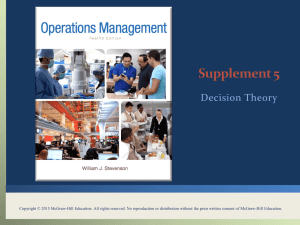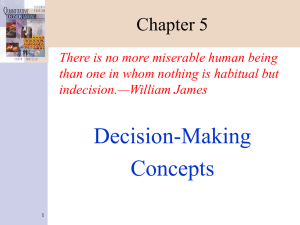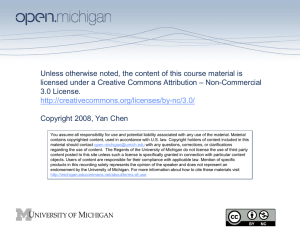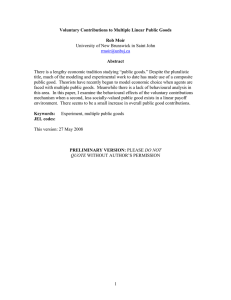PRODUCTIONS/OPERATIONS MANAGEMENT
advertisement
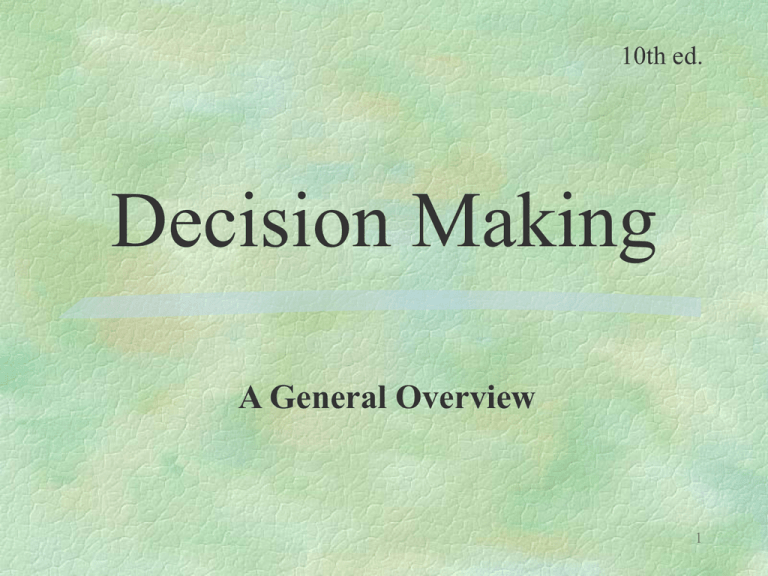
10th ed. Decision Making A General Overview 1 Why study decision making? -It is the most fundamental task performed by managers. -It is the underlying theme of the course. The techniques and tools employed in the text are intended to improve our decision making skills as managers. -It is assumed that a better understanding of decision making will lead to better decision by managers. 2 The Decision Process (Descriptive Model) Identify the Problem Specify objectives and the criteria for choosing a solution Develop alternatives Analyze and compare alternatives Select the best alternative Implement the chosen alternative Monitor the results 3 Some Key Elements which Managers Must Cope with in Their Decision Environment Uncertainty/Risk (and even luck) Complexity Change (including technological change) Behavioral/Political Considerations 4 Pareto Phenomenon • A vital few things are important for reaching an objective or solving a problem. • 80/20 Rule - 80% of problems are caused by 20% of the activities. How do we identify the vital few? 5 Models • A model is an abstraction of reality. – Physical – Schematic – Mathematical What are the pros and cons of models? 6 7 8 9 Systems Approach “The whole is greater than the sum of the parts.” Suboptimization 10 Causes of Poor Decisions (Cont’d) Suboptimization The result of different departments each attempting to reach a solution that is optimum for that department 11 Causes of Poor Decisions Bounded Rationality The limitations on decision making caused by costs, human abilities, time, technology, and availability of information 12 Some Very Basic Approaches to Decision Making Based on Decision Theory 13 Decision Theory Decision Theory represents a general approach to decision making which is suitable for a wide range of operations management decisions, including: capacity planning product and service design location planning equipment selection 14 Decision Making Conditions Certainty – Condition in which relevant parameters have known values Uncertainty – Condition in which it is impossible to assess the likelihood of various future events Risk – Condition in which certain future events have probable outcomes 15 Decision Making Under Certainty Examples of a criterion: Break Even Analysis: Decide to produce items if they lead to a profit 16 Example BE analysis 17 Decision Making under Uncertainty Examples of three criteria: Maximin - Choose the alternative with the best of the worst possible payoffs Maximax - Choose the alternative with the best possible payoff Laplace - Choose the alternative with the best average payoff of any of the alternatives 18 Try to do homework problem 1(a,b,c) on page 229 in the textbook 19 Decision Making under Risk Examples of two criteria: •Expected monetary value: calculate the expected value (average or mean) of each alternative, choosing the alternative with the best expected value •Expected value of perfect information: calculate the difference between the expected payoff under certainty and the expected payoff under risk 20 Format of a Decision Tree Decision Point Chance Event Payoff 1 Payoff 2 2 Payoff 3 1 B Payoff 4 2 Payoff 5 Payoff 6 21 Try to do homework problems 2(b,a,c), 10, and 11 on pp. 229-232. 22 Solutions to Homework Partial solutions are on the slides that follow. Be sure to try the problems before you look at the solutions. 23 1. 1. a . Maximax: Expand [$80 is the highest payoff] b . Maximin: Worst payoffs: c . Laplace: Do Nothing: $50 Expand: $20 Subcontract: $40 [best of the worst payoffs] Average Payoff Do Nothing $55 [Indifferent between Do Nothing Expand $50 And Subcontract] Subcontract $55 Comments on the above: Part (a) is simply the highest return of all possibilities in the table. Part (b) shows 50, 20, and 40 as the worst return for each of the three alternatives. Hence, the best of the worst is 50, and the answer is “Do Nothing.” Note that Part (c) simply finds the average for each alternative, l. Leading to a tie between Do Nothing and Subcontract. In a sentence 24 or two, could you find a method to break the tie? 2. Now that we have probabilities for High (.7) and Low (.3) demand, our problem changes from decision making under uncertainty (as in Problem 1) to decision making under risk (which allows us to build a decision tree as shown below). Low High 2 b. Low High Low act High 2a. The following gives the Expected Values (or Expected Payoffs) of the three alternatives for the above decision tree (this allows us to solve the above decision tree): EV(Do Nothing) = EVDN = (.3) (50) + (.7) (60) = 57 EV(Expand) = EVEXP = (.3) (20) + (.7) (80) = 62 EV(Sub-Contract) = EVSC = (.3) (40) + (.7) (70) = 61 Since EVEXP is the largest, we cut the branches for Do Nothing and Subcontract, and our solution is to “EXPAND.” Note that EVEXP is also our Expected Value (EVr) under 25 conditions of risk, which we will use in the problem for finding the EV of perfect information. 2. 2 b. act Note that we had three probability distributions on the tree in the previous slide, and replaced each distribution with its expected value (or average), allowing us to simplify the tree as shown above. Hence, as stated in the previous slide, our solution to the tree was to Expand since its payoff of $62 is larger than the payoffs of the other two alternatives. Note the cuts that we made on the above tree used the symbol “║”. 26 50 2c Low .3 .7 Do Nothing EVc = (.3) (50) + (.7) (80) = 71 High Expand 80 We draw the above tree which represents what we would do if we knew for certain that demand was to be Low (upper branch) or High (lower branch). The EV of the above tree would have to be our Expected Value under conditions of certainty. Hence, EVPI = EVc - EVr = 71 - 62 = 9, Or: Expected Value under conditions of certainty = EVc = (.3) (50) + (.7) (80) = $71 Expected Value under conditions of risk = EVr = -$62 EVPI (Expected Value of Perfect Information) = $ 9 27 10. .70 high 28 11. =EV5 29 In-Class Assignment (You will be asked in class how this problem could be solved. However, you need NOT solve this problem for class. We will do it together during the lecture. All you should do, at the minimum, is to read this problem carefully, and go to the next slide.) It is suggested that you make a hardcopy of this slide and the next slide, and bring the hardcopy to the next class. 30 (a) This is the structure of the decision tree for the problem above. Try to complete this tree (i.e., print out this slide and add the payoffs and the probabilities). (b) For a greater challenge, try to solve this tree using the monetary expected value criterion, and write a brief statement on what Joe should do. (c) Based on your answer in part (b), What is the probability that Joe could go bankrupt if bankruptcy occurs from a loss of $75,000? What is the probability of bankruptcy for a loss of $150,000? For even a greater challenge, and assuming that you were able to answer the above questions, write a sentence or two on how Joe could do something unethical in order to get a better return, if he later found the market test to be unfavorable. 31 Discussion Problem: Do not try to solve this problem. Simply read through it a few times. This problem will be solved in class as a computer application. Please make a hardcopy of this slide, and bring it to class. . 32 End of Session. See you during our next class meeting. 33






